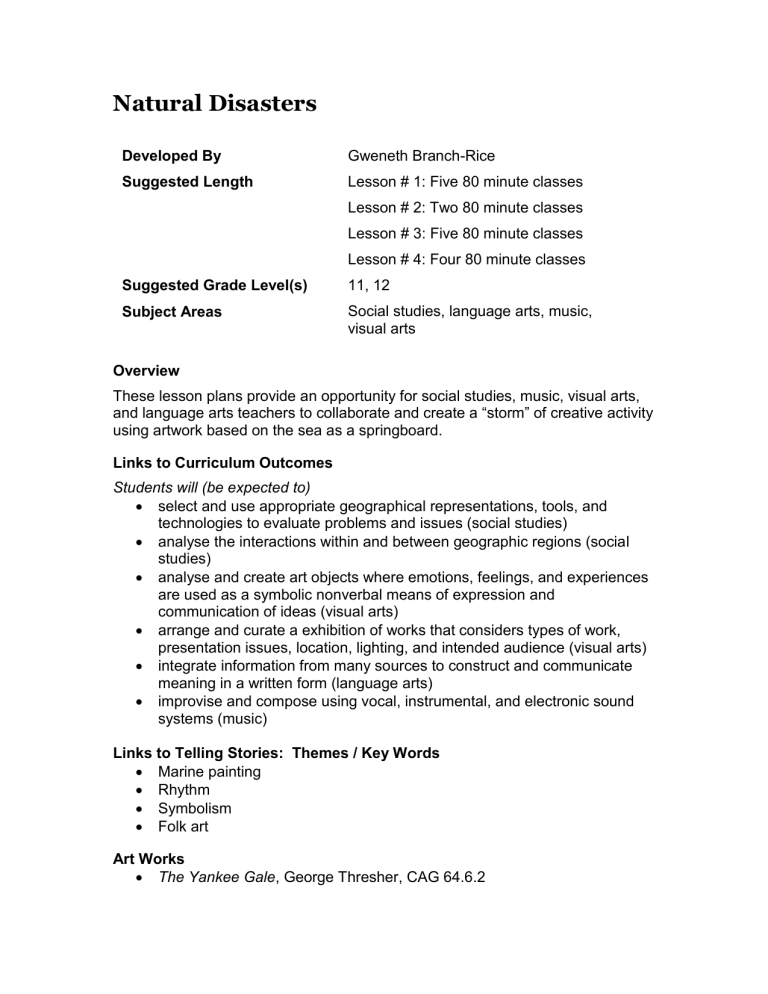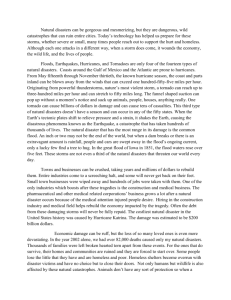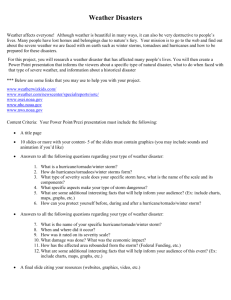Natural Disasters - Telling Stories: Narratives of Nationhood

Natural Disasters
Developed By
Suggested Length
Gweneth Branch-Rice
Lesson # 1: Five 80 minute classes
Lesson # 2: Two 80 minute classes
Lesson # 3: Five 80 minute classes
Suggested Grade Level(s)
Subject Areas
Lesson # 4: Four 80 minute classes
11, 12
Social studies, language arts, music, visual arts
Overview
These lesson plans provide an opportunity for social studies, music, visual arts, and language arts teachers to collaborate and create a “storm” of creative activity using artwork based on the sea as a springboard.
Links to Curriculum Outcomes
Students will (be expected to)
select and use appropriate geographical representations, tools, and technologies to evaluate problems and issues (social studies)
analyse the interactions within and between geographic regions (social studies)
analyse and create art objects where emotions, feelings, and experiences are used as a symbolic nonverbal means of expression and communication of ideas (visual arts)
arrange and curate a exhibition of works that considers types of work, presentation issues, location, lighting, and intended audience (visual arts)
integrate information from many sources to construct and communicate meaning in a written form (language arts)
improvise and compose using vocal, instrumental, and electronic sound systems (music)
Links to Telling Stories: Themes / Key Words
Marine painting
Rhythm
Symbolism
Folk art
Art Works
The Yankee Gale , George Thresher, CAG 64.6.2
I Triumphed and I Saddened with All Weather , William Kurelek, CAG
71.15
Lesson #1: The Tempest
Objective Students will create an expressive painting documenting their experience of a storm.
Related Art Works
The Yankee Gale , George Thresher, CAG 64.6.2
I Triumphed and I Saddened with All Weather , William Kurelek, CAG
71.15
Materials
paper or canvas board
paint
brushes
containers for water
palettes or plastic container lids to mix paint on
Activities
1. During a class discussion students will share stories of storms that they have experienced and then brainstorm a list of major storms that have happened in Canada in the past few years, such as:
Hurricane Juan in the Maritimes
Ice storms in Quebec
Red River flood in Manitoba
Forest fires in B.C.
2. Then have the class view, discuss, and analyse the paintings The
Yankee Gale and I Triumphed and I Saddened with All Weather .
Some ideas for discussion questions are:
How is colour used to evoke emotion in the art works?
How did the artist arrange the composition so as to give us a feeling for the power of weather?
In the work of William Kurelek, compare the reaction of the children and the adult to the flood.
3. Students create a list of personal stories about storms that they could recount in a visual way. Have them make preliminary drawings of two or three of their ideas.
4. Choosing their best visual idea students then create a painting.
Using colour and careful attention to composition, students will be able to express their personal feelings about their storm experience.
Computer Option
Search www.google.com
(Image search) for key words natural disasters , storms in Canada
Ideas for Assessment
Did the student use colour in an expressive way?
Did the student use compositional elements to give us an enhanced feeling for the storm? The teacher could use peer assessment methods to determine how easy the painting is to read.
Lesson #2: A Tumultuous Hullabaloo
Objective Using an art work as their inspiration, students will write a poem or short story using figures of speech in their writing.
Materials
paper
writing tools
Activities
Refer to Lesson #1 for ideas on how to begin the discussion of storms and some discussion questions about the art works.
1. After completing an introduction, divide the class into small groups.
Give each group two or three of the art works completed by the students in Lesson #1 and have the groups view, discuss, and analyse them.
2. Once they have listed words used to describe each painting, invite them to utilize these words in their own poem or short story.
Encourage students to utilize devices such as onomatopoeia, personification, imagery and metaphor.
Computer Option
Students could produce a slide show of the art works and the literary work using Corel Presentations. This slide show could be on display during parent teacher interviews and could be used as inspiration for other
Language Arts classes.
Lesson #3: Atmospheric Disturbances
Objective Students will view art work from Lesson #1, read literary work from
Lesson #2, and create an original musical accompaniment for them.
Materials
instrument(s)
alternative sound sources
musical notation paper
tape recorder
Activities
Refer to Lesson #1 for ideas on how to begin the discussion of storms and some discussion questions about the art works listed.
1. Have students form small groups and view, read, and discuss the art works created in Lessons 1 and 2.
2. Play “Royal Hunt” and “Storm” from Les Troyens by Hector Berlioz and a sample of Beethoven’s Symphony No. 6 in F major, Op. 68
(Pastoral) and discuss some of the ways that music can suggest a storm.
3. Students now add to their artistic creations by contributing their own original piece of music that responds to one of the storm visions. Creating a soundscape that uses alternative sound sources might be an effective musical option for students.
Choosing a way to look at the painting will also help to guide the students’ musical creation (e.g., reading the painting from left to right and noting changes in mood, colour, shape, and texture or looking at the overall mood of the entire work and responding to its atmosphere).
Ideas for Assessment
In small group or whole class discussion, have students explain what they were trying to achieve in their compositions, and invite other students to respond regarding how well the piece of music reflects the storm imagery.
Lesson #4: The Power of Weather
Objective Students will create a slide show presentation comparing and contrasting the impact and the response to a natural disaster in the
19th century with the impact and the response to a natural disaster that has happened in their lifetime.
Materials
paper
writing tools
access to computers
Activities
1. Initiate a class discussion about natural disasters by considering the image of The Yankee Gale and by asking students whether they have experienced a natural disaster themselves or know stories about someone who has.
2. Students now form small groups and assign each a modern natural disaster to compare and contrast with The Yankee Gale . Some sample questions for the students to answer about each storm are:
What was the impact each storm had on the environment?
Where and when did the natural disaster occur, including the time of day and the year?
What effect did time and place have on the magnitude of the disaster?
What if any geological conditions contributed to the storm?
Did the disaster occur in a primarily urban or rural area?
What assistance was available for the people who were affected by the disaster?
What organizations are involved in assisting in modern disasters and what is their role?
What special problems existed after the disaster?
3. Each group of students will research and present a slide show about their findings.
Computer Option
The web site www.google.com
would be useful for finding visual images.
There are a number of software packages that can be utilized to create slide shows (e.g., Microsoft Power Point Presentations, Corel
Presentations, and Inspiration).
Ideas for Assessment
Did the students answer the questions they were assigned in a comprehensive manner?
Was the slide show well organised and did it contain a number of pertinent visuals?
Bringing it all Together
All of this work and energy from many voices could culminate in a perfect artistic storm – an arts evening of music, poetry, prose, and visual displays.
Suggested Resources
The Island Magazine (Charlottetown, PEI Museum)
www.naturaldisasters.com
www.weatheroffice.ec.gc.ca/canada
www.fema.gov







